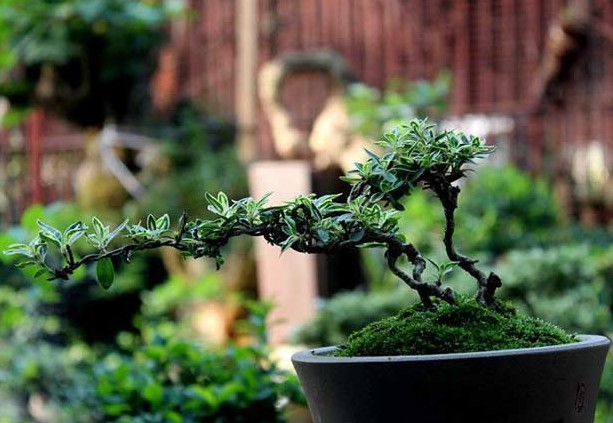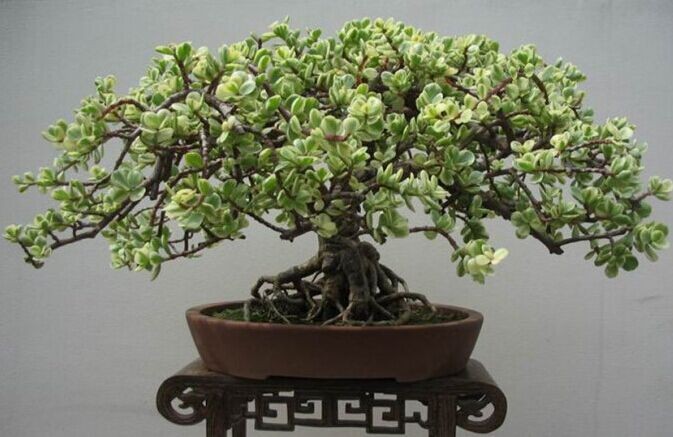Production method of snow bonsai in June
June snow, also known as the stars. It is a small evergreen or semi-evergreen shrub of Rubiaceae. The plant is low, with dense leaves, thin and soft branches, white florets in midsummer, as if covered with snow, with high ornamental value. Snow likes a wet and overcast environment and a warm climate in June. It is not strict with the soil and can grow on both neutral and slightly acidic soils. I prefer fat and water.

The production of snow bonsai in June needs to go through the following stages: pile source, processing modeling, transplanting on the basin, water and fertilizer management, light and temperature requirements, basin turning and pruning, pest control. The following is a detailed introduction to the production process of snow bonsai in June.
2. Processing modeling: it can be processed by "wood cutting and drying method", or by "cutting and binding method". Banding is usually carried out from semi-deciduous leaves in winter to sprouting in spring, the trunk and branches of June snow are tied with wire, and the branchlets are finely trimmed and shaped.
3, transplanting on the pot: it is appropriate to carry on in 2-3 months, choose the lighter purple sand basin or glaze basin, the basin color should be a little darker, contrast with the flower color. The basin soil is required to be a sandy loam rich in organic matter, loose and fertile, with good drainage and air permeability.
4. Light and temperature requirements: during the snow growing season in June, it should be placed in a sunny, warm, humid, well-ventilated place, shaded by 50% of the sun in early summer and autumn, and kept at room temperature of 5-12 ℃ in the north in winter.
5, water and fertilizer management: snow bonsai growing season in June should be often watered, not too dry and wet for a long time, spray water to the leaf surface 1-2 times a day in summer, reduce watering times in winter, and keep the basin soil moist and slightly dry. 0.5% phosphate and potassium fertilizer solution is applied 2-3 times a year from April to May, and thin organic fertilizer solution is applied 1-2 times in Ladong, which is not suitable for other seasons. Avoid applying thick fertilizer.
6. Turning the basin and pruning: turn the basin once every 1-2 years, in the spring from February to March or late autumn, remove all the old soil and trim the roots properly. It can be combined with turning the basin to lift the root to form a hanging root to improve the ornamental value. After the semi-deciduous leaves in winter to the sprouting of the following spring, plastic pruning is carried out, cutting long and ungrown branches, thinning the thin and weak branches that are too dense, cutting off the branches of diseases and insect pests and other messy branches that affect the ornamental; coring, wiping buds, removing branches and so on are carried out at the right time during the growing period. to keep it in a beautiful shape.
Time: 2019-05-26 Click:
- Prev

The method of making jade leaf bonsai
When the plants were basically formed after a year of cultivation, they entered the stage of potted plant manufacturing. Potted plant manufacturing can be carried out in spring, summer, autumn and winter in one year. According to the thickness, shape, staggered branches and planting position of plant materials, we can vote on whether to make single-stem type or double-plant or multi-plant co-planting type.
- Next

How to make co-planting bonsai
The so-called co-planting refers to the cultivation of more than three individual trees in flat or shallow pots to show the forest pattern. Some even as many as dozens, and with the increase in the number of dried plants, the feeling of lush is more powerful. When planting, each pot is mostly based on the same tree species, because, in this way, it is not only conducive to cultivation.
Related
- Fuxing push coffee new agricultural production and marketing class: lack of small-scale processing plants
- Jujube rice field leisure farm deep ploughing Yilan for five years to create a space for organic food and play
- Nongyu Farm-A trial of organic papaya for brave women with advanced technology
- Four points for attention in the prevention and control of diseases and insect pests of edible fungi
- How to add nutrient solution to Edible Fungi
- Is there any good way to control edible fungus mites?
- Open Inoculation Technology of Edible Fungi
- Is there any clever way to use fertilizer for edible fungus in winter?
- What agents are used to kill the pathogens of edible fungi in the mushroom shed?
- Rapid drying of Edible Fungi

